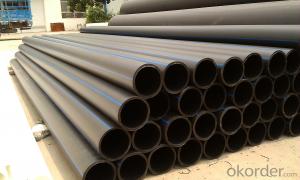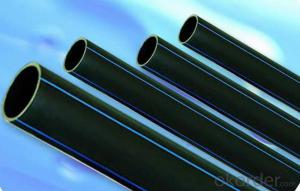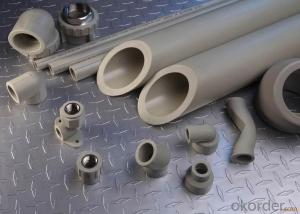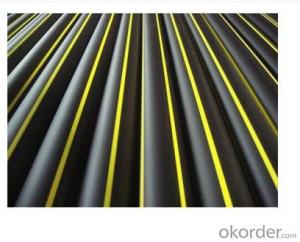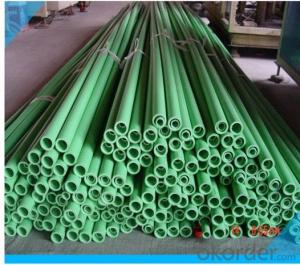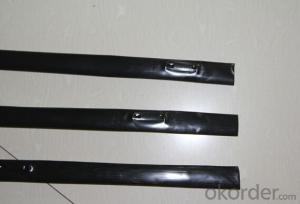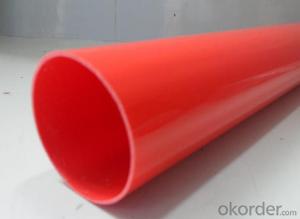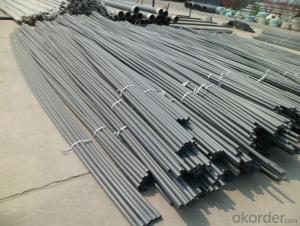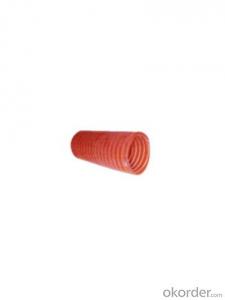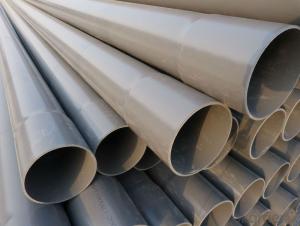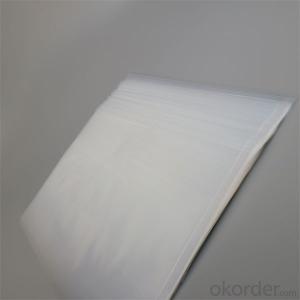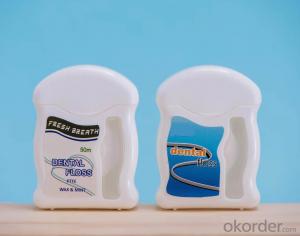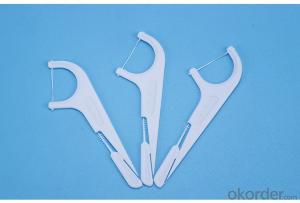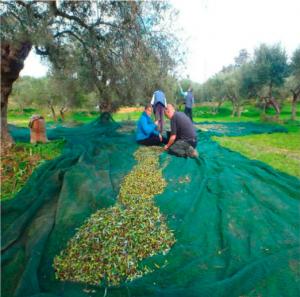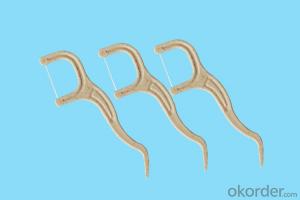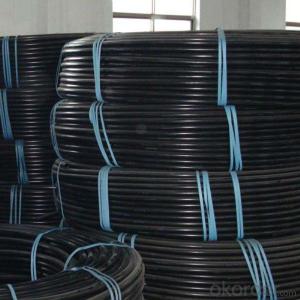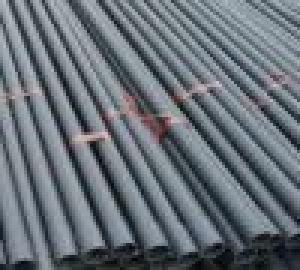HDPE PIPE ISO4427-2000 DN140
- Loading Port:
- China Main Port
- Payment Terms:
- TT OR LC
- Min Order Qty:
- -
- Supply Capability:
- -
OKorder Service Pledge
OKorder Financial Service
You Might Also Like
Physical properties[edit]
Polyethylene is a thermoplasticpolymer consisting of long hydrocarbon chains. Depending on the crystallinity and molecular weight, a melting point and glass transition may or may not be observable. The temperature at which these occur varies strongly with the type of polyethylene. For common commercial grades of medium- and high-density polyethylene the melting point is typically in the range 120 to 180 °C (248 to 356 °F). The melting point for average, commercial, low-density polyethylene is typically 105 to 115 °C (221 to 239 °F).it is transprant.
Chemical properties[edit]
Most LDPE, MDPE and HDPE grades have excellent chemical resistance, meaning that it is not attacked by strong acids or strong bases. It is also resistant to gentle oxidants and reducing agents. Polyethylene burns slowly with a blue flame having a yellow tip and gives off an odour of paraffin. The material continues burning on removal of the flame source and produces a drip.[3] Crystalline samples do not dissolve at room temperature. Polyethylene (other than cross-linked polyethylene) usually can be dissolved at elevated temperatures in aromatic hydrocarbons such as toluene or xylene, or in chlorinated solvents such as trichloroethane or trichlorobenzene.[4]
GB/T13663-2000:
| PE63管材规格 | |||||
| 公称 外径dn,mm | SDR33 | SDR26 | SDR17.6 | SDR13.6 | SDR11 |
| 公称压力 PN,Mpa | |||||
| 0.32 | 0.4 | 0.6 | 0.8 | 1.0 | |
| 公称 壁厚 | 公称 壁厚 | 公称 壁厚 | 公称 壁厚 | 公称 壁厚 | |
| 16 | 2.3 | ||||
| 20 | 2.3 | 2.3 | |||
| 25 | 2.3 | 2.3 | 2.3 | ||
| 32 | 2.3 | 2.4 | 2.9 | ||
| 40 | 2.3 | 2.3 | 3.0 | 3.7 | |
| 50 | 2.3 | 2.9 | 3.7 | 4.6 | |
| 63 | 2.3 | 2.5 | 3.6 | 4.7 | 5.8 |
| 75 | 2.3 | 2.9 | 4.3 | 5.6 | 6.8 |
| 90 | 2.8 | 3.5 | 5.1 | 6.7 | 8.2 |
| 110 | 3.4 | 4.2 | 6.3 | 8.1 | 10.0 |
| 125 | 3.9 | 4.8 | 7.1 | 9.2 | 11.4 |
| 140 | 4.3 | 5.4 | 8.0 | 10.3 | 12.7 |
| 160 | 4.9 | 6.2 | 9.1 | 11.8 | 14.6 |
| 180 | 5.5 | 6.9 | 10.2 | 13.3 | 16.4 |
| 200 | 6.2 | 7.7 | 11.4 | 14.7 | 18.2 |
| 225 | 6.9 | 8.6 | 12.8 | 16.6 | 20.5 |
| 250 | 7.7 | 9.6 | 14.2 | 18.4 | 22.7 |
| 280 | 8.6 | 10.7 | 15.9 | 20.6 | 25.4 |
| 315 | 9.7 | 12.1 | 17.9 | 23.2 | 28.6 |
| 355 | 10.9 | 13.6 | 20.1 | 26.1 | 32.2 |
| 400 | 12.3 | 15.3 | 22.7 | 29.4 | 36.3 |
| 450 | 13.8 | 17.2 | 25.5 | 33.1 | 40.9 |
| 500 | 15.3 | 19.1 | 28.3 | 36.8 | 45.4 |
| 560 | 17.2 | 21.4 | 31.7 | 41.2 | 50.8 |
| 630 | 19.3 | 24.1 | 35.7 | 46.3 | 57.2 |
- Q:Can plastic tubes be used for waste management systems?
- Yes, plastic tubes can be used for waste management systems. Plastic tubes are commonly used in various waste management applications such as drainage systems, sewer lines, and even for transporting waste materials in industries. Plastic tubes are durable, lightweight, and resistant to corrosion, making them suitable for handling different types of waste and ensuring efficient waste management.
- Q:Two identical strong magnets are dropped simultaneously by two students into two vertical tubes of the same dimensions (see figure below). One tube is made of copper, and the other is made of plastic.
- The magnet dropped through the plastic tube. Plastic doesn't conduct electric currents with anywhere near the ability of the copper tube. The magnet dropped through the copper tube will induce a voltage around the loop as per Faraday's law of induction. Such a voltage creates a current through the tube, and that current makes this copper tube act as an electromagnet. This electromagnet will apply a force to the magnet which opposes the gravitational force on the magnet. How do I know it will oppose? Because of conservation of energy. In order for the current dissipating heat in the copper tube (due to the voltage and current combination), the magnetic force MUST do negative work on the falling magnet, such that the magnet does work on the tube as it falls.
- Q:Why, in general, the strong tube is plastic tubes, weak tubes are metal tubes?
- Weak metal pipe is mainly anti-interference, shielding role. Strong PVC is because the cost material cost and construction low construction speed, simple process, smooth inner wall wear line resistance is small but low strength, in more than 40 pipes generally required chroma metal tube or galvanized metal tube special.
- Q:How do plastic tubes compare to carbon fiber tubes in terms of strength?
- Carbon fiber tubes are generally stronger than plastic tubes. Carbon fiber has a high strength-to-weight ratio and exceptional stiffness, making it a preferred choice for applications that require maximum strength and durability. Plastic tubes, on the other hand, have lower strength properties and are more prone to deformation or breakage under high stress or load conditions.
- Q:How do you prevent plastic tubes from becoming brittle in cold weather?
- One effective way to prevent plastic tubes from becoming brittle in cold weather is to use materials with high resistance to low temperatures, such as polyvinyl chloride (PVC) or high-density polyethylene (HDPE). Additionally, insulating the tubes or using protective coverings can help maintain a stable temperature and prevent extreme cold from affecting the plastic's properties. It is also essential to ensure proper installation and maintenance to avoid any potential damage or stress on the tubes that could lead to brittleness.
- Q:What are plastic tubes?
- Plastic tubes are cylindrical hollow structures made of various types of plastic materials, such as PVC, polyethylene, or polypropylene. They are commonly used for a wide range of applications, including packaging, transportation of liquids or gases, electrical insulation, plumbing, and medical devices. Plastic tubes offer flexibility, durability, and resistance to corrosion, making them versatile and cost-effective solutions in many industries.
- Q:Does anyone know if i can run a aftermarket air filter right off of my Mass air flow sensor and my stock intake tube down to my turbo? I have a 1998 Audi A4 1.8 turbo
- No, but K+N does make a filter the fits in the stock location for your car and a kit to put on a cone-type open element filter.
- Q:How do you measure the diameter of a plastic tube?
- To measure the diameter of a plastic tube, you can use a caliper or a ruler. Simply place the caliper jaws or the ruler across the widest point of the tube, ensuring that they are perpendicular to the axis of the tube. Take note of the measurement displayed on the caliper or the ruler, which represents the diameter of the plastic tube.
- Q:After extruding the plastic pipe, why is it not soaking, cooling, spraying cooling?
- You can verify that if you take soaking and cooling, you need to constantly add water, otherwise the water temperature will soon rise
- Q:Is it supposed to come off easy? Do I buy a new one a long with a flapper? My toilet is constantly running and water is flowing into the bowl.
- yes, you can purchase the complete flushvalve at any plumbing supply place.(lowes, home depot etc....) very inexpensive, these now come with a complete rebuild kit or you have the option to buy parts seperate. try the brand fluidmaster, comes complete. you will need to remove the tank and reassemble with a new tank to bowl gasket and bolts - best luck
1. Manufacturer Overview |
|
|---|---|
| Location | |
| Year Established | |
| Annual Output Value | |
| Main Markets | |
| Company Certifications | |
2. Manufacturer Certificates |
|
|---|---|
| a) Certification Name | |
| Range | |
| Reference | |
| Validity Period | |
3. Manufacturer Capability |
|
|---|---|
| a)Trade Capacity | |
| Nearest Port | |
| Export Percentage | |
| No.of Employees in Trade Department | |
| Language Spoken: | |
| b)Factory Information | |
| Factory Size: | |
| No. of Production Lines | |
| Contract Manufacturing | |
| Product Price Range | |
Send your message to us
HDPE PIPE ISO4427-2000 DN140
- Loading Port:
- China Main Port
- Payment Terms:
- TT OR LC
- Min Order Qty:
- -
- Supply Capability:
- -
OKorder Service Pledge
OKorder Financial Service
Similar products
New products
Hot products
Hot Searches
Related keywords
